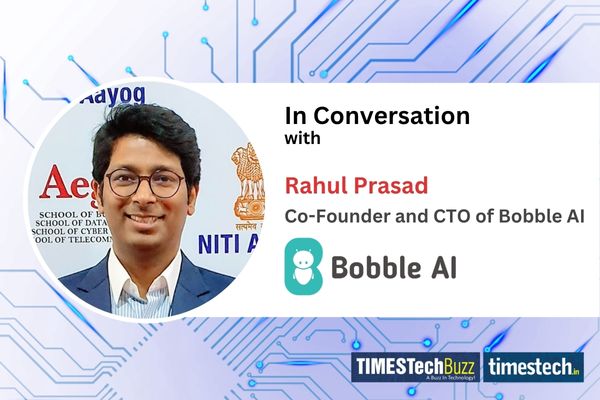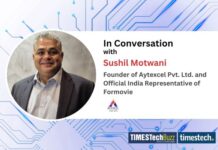In an interview with TimesTech, Rahul Prasad, Co-Founder and CTO of Bobble AI, discusses how the company is transforming digital communication using generative AI. From personalized replies to real-time translations and AI-generated content, Bobble AI’s keyboard is evolving into a smart assistant. Rahul shares insights on ethical AI, content authenticity, and the exciting future of agentic systems shaping communication in the years to come.
Read the full interview:
TimesTech: Generative AI is transforming how we create and consume content. How is Bobble AI leveraging this technology to redefine digital communication and content creation for everyday users?
Rahul: At Bobble AI, we have always believed that the keyboard should do more than just typing. It should help you express, connect, recommend, and get things done in the way you prefer. That’s why we have built a generative AI-powered keyboard that converts your phone into your personal assistant.
Let’s say you are replying to a colleague on LinkedIn, a friend on WhatsApp, or posting something on Facebook. Each platform has its signature style. Our ‘AI Reply‘ gets that; it picks up on the tone and context automatically. You might get a polished, professional draft for LinkedIn, a warm, casual line for WhatsApp, or something fun and expressive for Facebook. It’s not just about words; it’s about how we say them.
And the AI doesn’t stop there. You can paste any link and, in seconds, get a summary through the feature of ‘AI Summary.’ With our AI translation feature, you can have a conversation in Japanese even if you don’t know the language. Just write it in English, and the keyboard will handle the rest in real time.
Beyond chatting, we are enabling users to generate emojis, stickers, shayaris, poems, GIFs, wishes, and much more. Users can also generate personalized avatars, all in their language and style. Whether it’s Tamil, Bhojpuri, or Hinglish, we’ve trained our models to speak the way you do.
For us, generative AI isn’t just about automation; it is about making everyday conversations richer, more personal, and uniquely yours.
TimesTech: How do you balance innovation in generative AI with concerns around content authenticity, misinformation, and ethical use?
Rahul: While generative AI offers immense choices and possibilities, we ensure honesty, respect, fairness, and transparency in communications. Integrated moderation tools and content filters to generate communication minus harmful or misleading content. Additionally, we avoid creating deceptive visuals, focusing instead on content that is fun, creative, and culturally relevant. We acknowledge users’ trust and transparency in every stage of development at Bobble AI.
TimesTech: What are your thoughts on ethical AI? How does Bobble AI ensure its algorithms are transparent, unbiased, and privacy-respecting?
Rahul: Ethical AI is one of the prime objectives for us. We design our algorithms to be transparent, allowing users to understand how predictions and suggestions are generated. Most of our technologies are patented and available in the public domain to explore. To combat bias, especially in a linguistically diverse country like India, we train our models on a wide range of regional datasets and continuously refine them based on user feedback through our large community. By processing data on-device models, we can minimize data transmission and storage, ensuring user information remains secure. Our commitment to building AI that respects and empowers every user is going to be stronger with upcoming on-device SLMs.
TimesTech: With hyper-personalization becoming the norm, how do you see the fine line between relevance and intrusion evolving in AI-powered products?
Rahul: Hyper-personalization should enhance user experience, save time, and recommend without compromising privacy and comfort. We continuously work to strike the balance. Our model employs structured learning from user behavior in a privacy-friendly way. The learning or fine-tuning processes capture patterns, not identities. We first introduced personalization in mobile keyboards via auto corrections, word suggestions, smart sentence completion, content in real time, and keyboard themes. The mission is to enrich day-to-day conversations with delight and efficiency, not discomfort. As personalization grows smarter, respecting boundaries will become even more important. Data compliance involves giving users control and designing with empathy for delivering non-intrusive, meaningful personalization.
TimesTech: Looking ahead, what AI advancements or trends do you believe will shape the future of communication and user experience over the next 5 years?
Rahul: In the next five years, we will see and use integrated AI, meaning not only AI-trained models like ChatGPT but also integrated ones like Manus AI enhancing our daily communication. Beyond LLM models, we will see the emergence of end-to-end agentic systems like OWL, which can generate plans and execute those autonomously, converting our daily communications into commands.
Agentic AI will be the new norm; we will have answers to questions, solutions, and modes for efficiently executing them, monitoring outcomes, and even scope for necessary adjustments. This evolution will elevate our interactions with machines, especially when combined with the Internet of Things (IOT) and robotics, facilitating a wide range of tasks and communication.
New-age chips will enable the widespread adoption of on-device SLMs and VLMs, enabling smoother real-time, offline interactions that enhance privacy and responsiveness.
In addition, the rise of multimodal AI, which combines text, speech, and visuals, will keep adding a human-centric approach to all the conversations, making them more natural and expressive. AI systems will grow better at understanding context, cultural cues, and language nuances. When more and more traditional platforms start using AI, conversations with technology will feel more natural and personal. At Bobble AI, we are excited to be at the forefront of these developments, aiming to make digital communication more inclusive, intuitive, and natural.
















